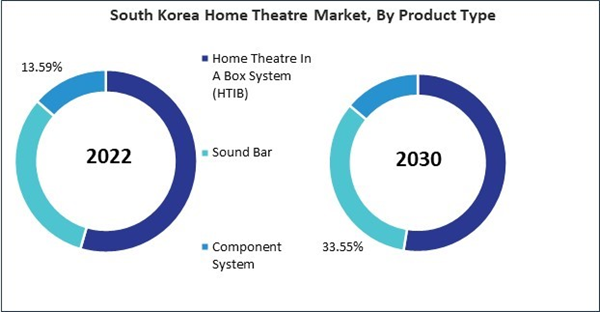The utilization of online channels in the Home Theatre Market has witnessed significant growth, offering consumers a convenient and expansive platform to explore, compare, and purchase home theatre products. Online retailers, including e-commerce platforms, manufacturer websites, and electronics-focused websites, provide consumers with a vast array of home theatre products from various brands, allowing them to browse product specifications, read reviews, and compare prices effortlessly. Therefore, the India market consumed 386.3 thousand units in the market in 2022.
The China market dominated the Asia Pacific Home Theatre Market, By Country in 2022, and would continue to be a dominant market till 2030; thereby, achieving a market value of $1,572.8 million by 2030. The Japan market is registering a CAGR of 8.8% during (2023 - 2030). Additionally, The India market would showcase a CAGR of 10.3% during (2023 - 2030).
The versatility of home theatre systems is further highlighted by their integration into smart home ecosystems. This integration aligns with the broader trend of smart homes, where technology converges to enhance convenience and connectivity. As per the data released in 2021 from the Government of India, the nation’s smart homes sector was estimated at US$ 355.411 Million in 2016, and it was expected to grow at a 43.75% growth rate from 2016 to 2020. Based on the provided growth rate, the market size for smart homes was estimated at US$ 1 Billion in 2021.
AI can provide personalized content recommendations by analyzing viewing habits, preferences, and even contextual factors. These recommendations extend beyond the traditional genre-based suggestions, delving into nuanced insights about user preferences. This enhances the content discovery process and introduces users to a broader spectrum of entertainment that aligns with their tastes. Furthermore, the demand for wireless connectivity solutions is rising, eliminating the need for cumbersome cable setups.
As the adoption of smart technologies becomes increasingly widespread among Chinese consumers, there is a growing demand for integrated and sophisticated home entertainment solutions. The concept of smart homes is gaining traction in China, with consumers adopting interconnected devices for various aspects of daily life. These systems are becoming integral to these smart home ecosystems, allowing users to control audio-visual settings, lighting, and other connected devices through a unified interface or voice commands. Thus, the growing smart homes and electronics sectors in the Asia Pacific can boost the demand for these systems in the region.
Based on Distribution Channel, the market is segmented into Offline and Online. Based on Product Type, the market is segmented into Home Theatre In A Box System (HTIB), Sound Bar, and Component System. Based on countries, the market is segmented into China, Japan, India, South Korea, Singapore, Malaysia, and Rest of Asia Pacific.
List of Key Companies Profiled
- Bose Corporation
- Sonos, Inc.
- Masimo Corporation
- LG Corporation
- Panasonic Holdings Corporation
- Samsung Electronics Co., Ltd. (Samsung Group)
- Sony Corporation
- Koninklijke Philips N.V.
- Toshiba Corporation
- Yamaha Corporation
Market Report Segmentation
By Distribution Channel (Volume, Thousand Units, USD Billion, 2019-2030)- Offline
- Online
- Home Theatre In A Box System (HTIB)
- Sound Bar
- Component System
- China
- Japan
- India
- South Korea
- Singapore
- Malaysia
- Rest of Asia Pacific
Table of Contents
Companies Mentioned
- Bose Corporation
- Sonos, Inc.
- Masimo Corporation
- LG Corporation
- Panasonic Holdings Corporation
- Samsung Electronics Co., Ltd. (Samsung Group)
- Sony Corporation
- Koninklijke Philips N.V.
- Toshiba Corporation
- Yamaha Corporation









